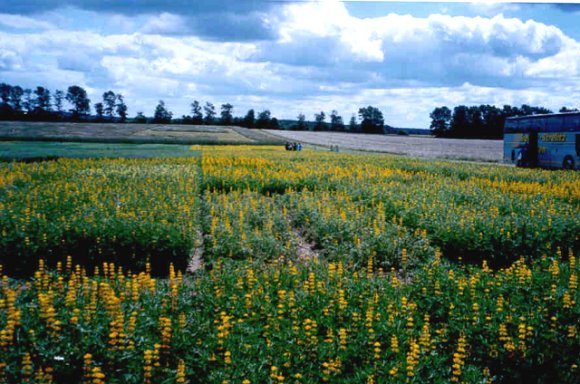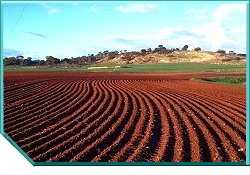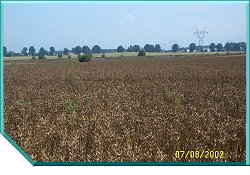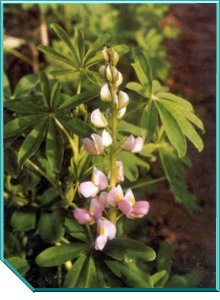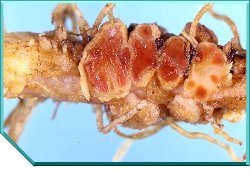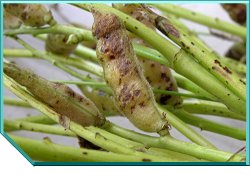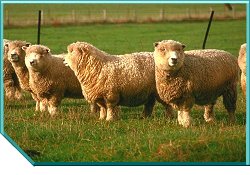PRODUCTION

    |

Farming Technology and Marketing
Access to the best technology and professional support is critical to making lupins part of a profitable farm business.
- Varieties & Seed Suppliers
- Agronomy & Farming Systems
- Lupin Growth & Development
- Crop Nutrition
- Weed Management
- Diseases & Pests
- Grazing & Feeding
- Marketing
![]()
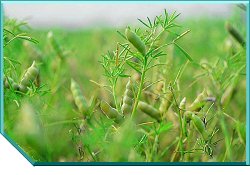 Varieties with improved agronomic characteristics, particularly yield and disease resistance, continue to be produced by breeding programs in Australia, Chile, Denmark, Germany, Poland, Russia, Ukraine and USA.
Varieties with improved agronomic characteristics, particularly yield and disease resistance, continue to be produced by breeding programs in Australia, Chile, Denmark, Germany, Poland, Russia, Ukraine and USA.
L. angustifolius breeding has been by far the major focus in Australia.
L. albus and L. luteus have received more attention in Europe and the former USSR but breeding of L. angustifolius is increasing.
|
Currently recommended lupin varieties in Australia |
||||||
| Name | Maturity | Anthracnose resistance | Aphid resistance | Brown spot resistance | Metribuzin tolerance | Grain protein |
| L. angustifolius | ||||||
| Belara | Very Early | Intermediate | High | Low | Intermediate | Low |
| Coromup | Early | High | High | Intermediate | High | High |
| Jindalee | Late | Low | High | Intermediate | Intermediate | Intermediate |
| Kalya | Early | Intermediate | High | Intermediate | High | Intermediate |
| Mandelup | Very Early | High | High | Low | High | Intermediate |
| Merrit | Early | Intermediate | High | Intermediate | High | Intermediate |
| Moonah | Early | Intermediate | High | Intermediate | Intermediate | Intermediate |
| Myallie | Early | Low | Low | Intermediate | Intermediate | High |
| Quilinock | Early | Very Low | Low | Intermediate | Intermediate | Intermediate |
| Tanjil | Early | Very High | High | Intermediate | Low | Intermediate |
| Wonga | Early | Very High | High | Intermediate | Low | Intermediate |
| L. albus | ||||||
| Andromeda | Late | Intermediate | High | Low | Low | High |
| Kiev Mutant | Mid | Very Low | High | Low | Low | High |
| Luxor | Late | Very Low | High | Intermediate | Low | High |
| Rosetta | Late | Very Low | High | Intermediate | Low | High |
| L. luteus | ||||||
| Pootalong | Early | Low | Very Low | High | Low | Very High |
| Wodjil | Early | Low | Very Low | High | Low | Very High |
Phomopsis resistance for all varieties is high to intermediate.
Variety recommendations are based on relative yield the importance of agronomic attributes in a particular agroecological zone.
PDF Brochures - Varieties
Mandelup VMP from Pulse Australia
Adobe Acrobat Document
499kb PDF (left click to download)
This Variety Management Package from Pulse Australia describes the agronomic requirements for MandelupA lupins in eastern Australia.
MandelupA is an early flowering and maturing variety with low alkaloid content. It has shown excellent vigour and harvest height in low rainfall regions. It was selected for its high yield, anthracnose resistance and tolerance to metribuzin in WA.
MandelupA has improved anthracnose resistance over QuilinockA and JindaleeA, but less than WongaA. It has also shown to be consistently high yielding across the southern states in the short season, low rainfall environments.
Mandelup agronomic recommendations for Western Australia
Adobe Acrobat Document
95kb PDF (left click to download)
This Farmnote from the Western Australian Dept of Agriculture and Food describes the management requirements for MandelupA lupins in WA.
Mandelup was released in 2004. It is a high yielding, early maturing variety with better tolerance than Belara to metribuzin, anthracnose and aphids (except green peach aphid). It has good early vigour and slightly higher protein levels than Belara in the grain. Mandelup is the suggested variety for all lupin-growing zones except where the risk from anthracnose is high (zone 1). It has consistently produced higher yields than other varieties in crop variety testing trials.
Albus Lupin- Andromeda, an anthracnose tolerant variety for WA
Adobe Acrobat Document
109kb PDF (left click to download)
This Farmnote from the Western Australian Dept of Agriculture and Food describes the management requirements for AndromedaA lupins in WA.
Andromeda is a new variety of albus lupin with considerably better tolerance to anthracnose than Kiev Mutant. It allows albus lupin to be cultivated in the medium rainfall zone without the risk of serious loss from disease. Andromeda should not be grown in regions receiving high rainfall where blue lupins (Lupinus cosentinii) are common. Blue lupins carry anthracnose and the chances of infection are greater where rainfall is high. Andromeda does not have sufficient tolerance to allow production without risk of substantial yield loss in these regions.
Albus Lupin- Luxor, a new variety from NSW DPI
Adobe Acrobat Document
659kb PDF (left click to download)
This Variety Management Package from Pulse Australia describes the agronomic requirements for LuxorA lupins in eastern Australia.
BREEDING: LuxorA (tested as WK142) was bred by Dr David Luckett and the Lupin Breeding Team from the NSW Department of Primary Industries at Wagga Wagga). It was produced from a cross between Kiev Mutant and Lucky-1 (a selected line from a French variety, Lucky, which originated from a Portuguese population).
VARIETY CHARACTERISTICS: LuxorA is a sweet albus lupin that has consistently achieved higher yields than both Kiev Mutant and Ultra. It was selected for its Pleiochaeta Root Rot resistance. LuxorA is a little taller than both Kiev Mutant and Ultra, and flowers four days later than Kiev Mutant after a mid-May sowing. Grain quality is similar to both Kiev Mutant and Ultra (seed colour, size and protein). The seed shape is flat and not too rounded, and is suitable for all existing human-consumption and livestock markets.
Albus Lupin – Rosetta, a new variety from NSW DPI
Adobe Acrobat Document
657kb PDF (left click to download)
This Variety Management Package from Pulse Australia describes the agronomic requirements for RosettaA lupins in eastern Australia.
BREEDING: RosettaA (tested as WK159) was bred by Dr David Luckett, Ms Kate Landers, and the Lupin Breeding Team from NSW Department of Primary Industries at Wagga Wagga). It was produced from a cross made in WA by Dr Bevan Buirchell between a Russian variety, Start, and P23277 (a Ukrainian breeding line also known as M-5).
VARIETY CHARACTERISTICS: RosettaA is a sweet albus lupin that has consistently achieved higher yields than both Kiev Mutant and Ultra. It was selected for its high yield and improved resistance to Pleiochaeta root rot. RosettaA is taller than both Kiev Mutant and Ultra, and flowers eleven days later than Kiev Mutant after a mid-May sowing. Grain quality is similar to both Kiev Mutant and Ultra (seed colour, size and protein). The seed shape is flat and not too rounded, and is suitable for all existing human-consumption and livestock markets. Rosetta has higher yield than Luxor, but Luxor should be preferred if Pleiochaeta Root Rot pressure is high.
Independent Sowing Guides
Poland
Research Centre for Cultivar Testing
South Australia
Department of Primary Industry
United Kingdom
PGRO (Processors and Growers Research Organisation)
NIAB (National Institute of Agricultural Botany
Western Australia
Department of Agriculture and Food
Commercial lupin seed suppliers
Australia
AWB Seednet
www.awb.com.au/growers/awbseeds/seednet
COGGO Seeds
Coorow Seeds
Grain Trust
Chile
Semillasbaer
Germany
Saatzucht Steinach
South Africa
Agricol
www.agricol.co.za
United Kingdom
Innoseeds
|
|
![]()
|
Lupins are important components of farming systems on deep, infertile sands in Australia, Germany, Poland and Russia. They are harvested for grain, green manured or made into silage. Often the grain produced is fed on-farm to livestock. Lupins being a nitrogen fixing legume have developed a special role as a rotation crop with wheat and other cereals. They can also benefit the following crop by reducing disease burdens. Similarly, the longer the gap between lupin crops the lower the risk of lupin diseases.
In Australia, lupins are grown in regions of winter dominant rainfall and the crops (L. angustifolius, L. albus and L. luteus) are autumn sown with terminal drought determining crop ripening. In Northern Europe the same lupin species are spring sown and grown over summer with the season start dictated by soil temperature for germination.
The value of lupins is not determined just by the return from the harvested grain; factors such as the disease break for following crops, nitrogen fixation by lupins and the value of stubble and lupin grain for stock feed must be considered, or the profitability of lupins will be underestimated. It is therefore important to look at lupins in rotation with other crops and not in isolation.
Australia
The rapid expansion of the narrow-leafed lupin (L. angustifolius) and development of agronomic techniques have helped transform the region in Western Australia where deep sands predominate into one of the most profitable grain growing regions in Australia. Wheat yields and protein levels are increased when grown after lupins.
The desire of farmers in Western Australia to grow lupins in frequent, intensive rotations with cereal has led to the increased difficulty managing weeds. Some weed species in these systems have developed resistance to herbicides. In response lupins are being cropped less frequently by some farmers. A range of new techniques are being developed for situations where intensive lupin cropping is desirable.
West Australian Herbicide Resistance Initiative: www.wahri.agric.uwa.edu.au
Crop Establishment
The goals in establishing a lupin crop are:
- Effective pre-sowing weed control
- Optimum plant density (usually 45 plants per square metre)
- Effective incorporation of any pre-planting residual herbicides
- Surface stubble retention
- Placement of the seed at the correct depth
- Loosen soil below the seed for quick root growth
- Adequate fertiliser, placed separate from the seed to avoid toxicity
- Relatively loose soil above the seed
Several lupin establishment goals may be in conflict and some compromise is usually necessary. Each situation must be carefully examined so that the chosen compromise is that most likely to result in good, low risk crop establishment.
PDF Link: Lupin Establishment in Western Australia.pdf
Minimum or zero tillage is highly suitable for lupins. The cereal stubble provides protection for the seedling lupin plant. This is important on sandy soils where wind erosion may be a problem and the lupin plant may suffer from wind blasting. Stubble also helps to reduce splash of brown spot spores.
Western Australian No Till Farming Association: www.wantfa.com.au
Harvesting
|
Lupins should be harvested as soon as they are ripe. Delays can result in significant yield losses due to lodging, pod shattering and pod drop. Lupins must be harvested within three weeks of maturity.
A moisture meter should be used to determine when the lupin crop is ready, and harvest should start as soon as the moisture content reaches 14 per cent. In some seasons this will occur when the stems are still pale green.
PDF Link : Lupin harvesting in Western Australia
Europe
|
The European Grain Legume Association hosts a website which overviews the current production and potential of different lupins species in the EU in comparison to other grain legume species.
The United Kingdom recently established the Lupins in Sustainable Agriculture (LISA) program.
North America
Lupins (L. albus, L. angustifolius and L. luteus) were first evaluated as a green manure crop in the 1940s in orchards and more recently as an alternative to wheat in doublecropping systems on the acid sandy soils of south-eastern USA.
Reeves, D.W., van Santen, E. & Mullins, G.L. (1996) Tillage and rotation effects on doublecropped white lupin in the southern USA. In: Proceedings of the 8th International Lupin Conference, Asilomar, California: 69-73
L. albus and L. angustifolius have also been evaluated in the Mid West and the Pacific North West.
Payne, W.A., Chen, C. & Ball D.A. (2004). Agronomic potential of narrow-leafed and white lupins in the inland Pacific North West. Agronomy Journal 96: 1501-1508.
www.ext.nodak.edu/extpubs/alt-ag/lupin.htm
PDF and Internet Resources
Growing yellow lupins in Western Australia
Adobe Acrobat Document
55kb PDF (left click to download)
This Farmnote from the Western Australian Dept of Agriculture and Food describes the management requirements for Yellow lupins (L. luteus) in WA. It is relatively old and should be updated in the coming year.
Yellow lupin (L. luteus), a new crop species for Western Australia's wheatbelt, has greater tolerance than narrow-leafed lupin to soil acidity, brown leaf spot, Pleiochaeta root rot and Eradu patch. It also has greater tolerance to waterlogging and manganese deficiency than narrow-leafed lupins. The first yellow lupin cultivar suitable for Western Australian wheatbelt conditions, Wodjil, was released by Agriculture Western Australia in 1997 and became available to commercial growers at the end of 1998. Wodjil yellow lupin is immune to cucumber mosaic virus and CMV seed testing is not necessary, but it is more susceptible to anthracnose than narrow-leafed lupin.
UK website for developing lupin production
Lupins in Sustainable Agriculture
This website details the investigations into the use of lupins in agriculture in the United Kingdom.
Spring Lupins can provide a high protein grain of known provenance and source of oils and balanced energy for optimised ruminant and non-ruminant livestock production. They have the potential to increase the efficiency of N and P use in arable rotations and in mixed arable livestock systems.
This five year project is the first comprehensive evaluation of the advantages and disadvantages of this crop for organic and conventional use in the UK. Comparisons with other grain legumes will analyse on farm nutrient budgets, feed utilisation, emissions from animal wastes and agronomic factors. Molecular markers for key traits will be identified and brought together as a ‘breeder’s toolkit’ available for Lupin improvement.
NSW DPI site for Lupin & Pulse information
Lupin, chickpea and other pulses
This webpage from the New South Wales Department of Primary Industries contains information about growing lupins in NSW.
Victorian DPI factsheet on lupins and pulses
Adobe Acrobat Document
43kb PDF (left click to download)
This fairly old, but still relevant, factsheet from the Victorian Department of Primary Industries contains information about growing lupins in Victoria.
DAFWA Crop Updates Feb 06 – lupins and pulses
Adobe Acrobat Document
784kb PDF (left click to download)
This file contains a summary of lupin production in the 2005 season in Western Australia, as well as the R&D highlights from the WA Dept of Agriculture and Food.
DAFWA Crop Updates Feb 06 – weed control in lupins and pulses
Adobe Acrobat Document
779kb PDF (left click to download)
This file details the R&D work performed in 2005 on weed control in lupins by the Western Australian Department of Agriculture and Food.
CLIMA newsletter - article on Albus lupins for eastern Australia
Adobe Acrobat Document
536kb PDF (left click to download)
Page 4. At the recent Open Day for the EH Graham Centre for Agricultural Innovation at Wagga Wagga, two new albus lupin varieties were commercially released by NSWDPI: Luxor and Rosetta. They are the first albus varieties in Australia with Pleiochaeta Root Rot resistance, and they also have significantly improved yields.
![]()
The development of the lupin plant (L. angustifolius) from germination to seed ripeness is described in botanical detail by Dracup M & Kirby E.J.M. (1996) Lupin Development Guide (University of Western Australia Press).
|
Germination and emergence
Lupins have epigeal germination pushing both cotyledons above the soil surface. Germination requires an adequate level of soil moisture and rate of emergence depends on moisture, temperature and sowing depth.
Vegetative growth
Lupins have a compound leaf made up of 5 – 12 elongated leaflets borne on a relatively long petiole that is subtended by 2 stipules. Some species, such as L. luteus may have a distinct early rosette stage prior to a period of rapid stem elongation and flowering. The rate of leaf initiation is dependent on temperature and day length.
Flowering
Some lupins have a low temperature vernalisation requirement to initiate flowering. The mature flower has fused sepals and the corolla has 5 free petals (a large standard and 2 wings that envelop 2 keel petals). Stamens are fused at the base to form a tube which bears both long and short filaments. A single ovary has a curving style. The arrangement of flowers in whorls along the peduncle varies with lupin species, as does the length of the flower spike and the colour of the petals.
Pod and seed ripening
During the early stage of pod development there is strong competition for assimilates with vegetative growth elsewhere in the plant which influences successful pod set. Colour changes of the pod (from green through khaki to light brown) and the developing cotyledons in the seed (from green to yellow) are useful indicators of the physiological stage of maturation.
The root system
Most lupins have a dominant tap-root and mature plants can have a rooting depth exceeding 2 metres on favourable soil-types.
Nodules containing the nitrogen fixing bacteria (Bradyrhizobium lupini) are mainly formed on the top 5-10 cm of the tap root and first appear 3-4 weeks after germination.
Some species, notably L. albus, develop prominent proteoid (cluster) roots that appear to have a role in the solubilisation of micronutrients. Only a low level of infection by mycorrhizal fungi occurs in lupins.
![]()
The level and balance of plant nutrients in the soil have a major influence on lupin growth and yield. Lupin species vary in their requirement for different nutrients (eg. L. albus is more prone to zinc deficiency than L. angustifolius whilst the opposite is true of manganese).
Correct fertiliser decision making can markedly influence profitability.
Harvesting 2 tonnes/ha of lupin grain removes the equivalent of 240kg of urea, 80kg of superphosphate and 40kg of muriate of potash per hectare as well as other micronutrients.
Link: DAWA Farmnote 16/95
Nitrogen
|
Lupins fix atmospheric nitrogen in root nodules formed by the soil bacterium Bradyrhizobium. The symbiosis is very tolerant of low soil pH but can become limiting at pH > 8, particularly in L. angustifolius.
Inoculants containing selected strains of Bradyrhizobia can be applied with the seed or in the planting furrow to ensure adequate nodulation occurs.
Inoculation is not required every season if a well nodulated lupin crop has been grown in the same field within 3-4 years.
A nodulated lupin crop will rarely respond to additional nitrogenous fertilizer
www.alosca.com.au
Phosphorus
In Western Australia lupins invariably require phosphatic fertiliser to achieve optimum yields. The rates required are influenced by the P concentration and P binding capacity of the soil and the expected yield potential of the crop. Rates of 20kgP/ha are typically required for L. angustifolius and L. albus. L. luteus has a much lower requirement owing to an enhanced ability to solubilise fixed P in the soil.
Potassium
Soil type strongly influences risk of K deficiency. On sandy soils K can be readily leached. Soil K levels below 30ppm are likely to result in deficiency.
Manganese
Manganese deficiency results in split seed disorder in lupins. Manganese is very immobile in soil and correction of deficiency is sometimes more efficient through foliar application of this nutrient.
Banding manganese fertiliser for lupins
Adobe Acrobat Document
123kb PDF (left click to download)
Manganese is needed on acidic soils in WA to prevent “split seed”. This Farmnote from DAFWA detailed the problem and a method of applying Mn for maximum effect.
Banding manganese (Mn) below the seed while sowing is the best method of applying Mn fertiliser for lupin grain production. In trials, top-dressing Mn before sowing was the most unproductive form of application, followed by drilling the fertiliser with the seed. These trials showed that grain yield increases were larger when Mn fertiliser was banded below the seed. Manganese foliar sprays will also correct Mn deficiency in lupin if applied when the pods are two to three centimetres long on the main stem.
West Australian Fertiliser Companies:
CSBP Fertilisers
www.csbp.com.au
United Farmers Co-operative
Whitford Fertilisers
Rural Liquid Fertilisers
![]()
|
Weed control in lupins should be part of an integrated weed management system for the cropping rotation.
Herbicides
Simazine (or related triazine herbicides) is a pre-emergent herbicide used routinely on lupin crops in Australia and many other parts of the world. There are restrictions on the use of this herbicide group in parts of the EU on environmental grounds.
A wide range of grass selective herbicides are safe to use on lupins but the range of post-emergent options to control broad-leafed weeds is less.
Cost, crop safety and weed control efficacy influence herbicide selection. Lupin species and varieties within a species can vary significantly in herbicide tolerance.
|
Commonly used selective herbicides on lupins in Australia |
|||
| Trade Name | Chemical Name | Group | Target weeds |
| Pre-emergent | |||
| Simazine | simazine | C | grasses, crucifers, capeweed, clover |
| Treflan | trifluralin | D | ryegrass, wireweed |
| Stomp | pendemethalin | D | ryegrass, wireweed |
| Post-emergent | |||
| Lexone | metribuzin | C | grasses, crucifers |
| Brodal | difluphenican | F | crucifers |
| Sniper | picolinafen | F | wild radish |
| Eclipse | metosulam | B | wild radish |
| Verdict | haloxyfop | A | grasses |
| Select | clethodim | A | grasses |
Herbicide resistant weeds
In Western Australia the emergence of annual ryegrass (Lolium rigidum) with resistance to grass selective (Group A) herbicides and wild radish (Raphanus raphanistrum) with resistance to sulphonyl ureas (Group B) herbicides has become widespread and has created additional challenges for growers.
Link: Integrated weed management PDF
PDF Brochures
CLIMA newsletter - article on herbicides for lupins in Western Australia and virus spread in lupins
Adobe Acrobat Document
784kb PDF (left click to download)
Page 3. CLIMA scientist Dr Ping Si, based at the University of Western Australia, has identified several mutant narrow-leafed lupin lines highly tolerant to the herbicide metribuzin. These mutants were induced from the cultivar Tanjil. At an application rate much higher than the recommended rate in the field, all conventional Tanjil seedlings were killed by metribuzin, but seedlings of the mutants had no leaf damage and grew healthily despite the high rate.
![]()
|
It was not until lupins were domesticated as a low alkaloid grain crop, midway through the 20th century, that pests and disease were recognised as economically important. Lupins are now cultivated in many contrasting environments around the world which influences the spectrum and severity of pest and disease challenge.
Integrated pest and disease management strategies have been successfully employed in many parts of the world to minimise crop losses.
| Disease | Pathogen | Tissue Affected | Major Symptom |
| Brown spot | Pleiochaeta setosa | All Foliar | Brown-black spots on leaves, stems and pods |
| Anthracnose | Colletotrichum lupini | All Foliar | Lesions containing pink-orange spores twisting, distorting or severing stems, petioles and pods |
| Phomopsis | Diapothe toxica | Stems, pods | Stem, pod and seed infection (produces mycotoxin) |
| Sclerotinia stem rot | Sclerotinia sclerotiorum | Stems | White fungal growth containing black sclerotia in upper stem or branches causing stem death |
| Bean Yellow | Bean Yellow Mosaic Virus | Systemic | Brown streaks moving away from shepherds crook at growing tip, associated with leaf yellowing |
| Cucumber Mosaic | Cucumber Mosaic Virus | Systemic | Plants stunted with pale leaves bunched and turned down |
| Grey leaf spot | Stemphyllium botryosum | All Foliar | Small grey circular lesions on leaves and pods |
| Cladosporium leaf spot | Cladosporium sp. | All Foliar | Dark grey spotting on leaves in humid spring conditions |
| Grey mould | Botrytis cinerea | Stems, pods | Lesions, containing grey fungal growth girdling stems and branches, abortion of flowers and pods |
| Powdery mildew | Erisphe polygoni | All foliar | White powdery fungal growth on leaves, stems and pods |
| Rhizoctonia bare patch | Rhizoctonia solani (AG8, ZG1) | Roots | Dark brown lesion severing taproot, causing distinct patches in crop |
| Eradu patch | Rhizcotonia sp. | Roots | Reddish brown root lesion stripping cortex of root, causing distinct patches in crop |
| Rhizoctonia hypocotyl rot | Rhizoctonia solani (ZG3 & ZG4) | Hypocotyl | Reddish brown sunken lesions on hypocotyl |
| Rhizoctonia hypocotyl and root rot | Rhizoctonia solani (ZG6) | Roots, hypocotyll | Reddish brown sunken lesions on hypocotyl and/or reddish brown lesions on roots |
| Pleiochaeta root rot | Pleiochaeta setosa | Roots | Dark brown lesions stripping cortex or completely rotting root |
| Sclerotinia collar rot | Sclerotinia minor | Stem | White fungal growth and small black sclerotes on upper tap root |
Source Geoff Thomas (Department of Agriculture and Food Western Australia)
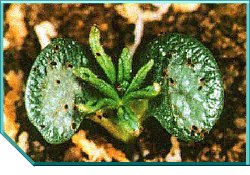
Red-legged earth mite feeding on a L. luteus seedling
PDF Link: Diseases and Pests of Lupins
PDF and Internet Resources
Aphid and viruses in Lupins, modelling forecast, feeding damage and virus spread.
Lupin virus
This comprehensive webpage from the Western Australian Department of Agriculture and Food details the impact of viruses and aphids on lupin production in WA.
2005 crop updates- diseases and pests of lupins
Adobe Acrobat Document
452kb PDF (left click to download)
The effect of simazine on brown spot tolerance of lupins in the 2004 season is detailed in this paper prepared for the 2005 DAFWA Crop Updates.
Brown spot and Pleiochaeta root rot disease of lupins
Adobe Acrobat Document
336kb PDF (left click to download)
This Farmnote from the Western Australian Department of Agriculture and Food outlines infection cycle, symptoms and regions of risk for brown spot and Pleiochaeta root rot in lupins. It presents a management package including rotation, stubble mulching, sowing date, tillage, depth of sowing, phosphorus nutrition, seeding machinery, seeding rate and suitable varieties.
Brown spot and Pleiochaeta root rot, caused by the fungus Pleiochaeta setosa, are responsible for the greatest disease losses to Western Australian lupin production. The effects are so important that they dictate rotational break and crop establishment methods over most of WA.
Lime and narrow leaf lupins
Narrow Leaf Lupins
A selection of 7 files from the Western Australian Department of Agriculture and Food about the use of lime to ameliorate acidity and the consequent effects on lupin production in Western Australia.
Brown spot in lupins in Victoria
This Ag note from the Victorian Department of Primary Industries gives a good background to the impact and control of born spot in Victoria.
The most important disease of the narrow-leaf lupin (Lupinus angustifolius) in Victoria is brown leaf spot which is caused by the fungus Pleiochaeta setosa.
Lupin plants may be infected at any stage of growth but, under Victorian conditions, brown leaf spot is most important from emergence until rapid growth starts in early spring. Later, as the lupins approach maturity and are growing more rapidly, loss of some lower leaves from disease is of little consequence.
![]()
|
Grazing Stubbles
Lupin seed losses during harvesting can exceed 150kg/ha, making lupin stubble residues a very nutritious livestock fodder for grazing in-situ.
Sheep and beef cattle tend to do better on lupin stubble than on cereal stubble because of the high energy value and protein content of the remaining seed. The low starch content of lupin seed also virtually eliminates the risk of digestive upsets (lactic acidosis) common when they are introduced to cereal stubbles.
Care should be taken not to overgraze stubbles to the extent that the soil surface is exposed to erosion risk.
Lupinosis
Lupinosis is caused by toxins produced by the fungus Diaporthe toxica which grows on lupin stubbles. As a clinical entity, lupinosis was first recognised in 1872 in Germany when numerous sheep deaths were associated with ingestion of the plant. Since then, lupinosis has been reported in the USA, Poland, New Zealand, Australia, the Republic of South Africa and Spain. However, it is in Australia where the lupin stubbles have been extensively used a fodder, that lupinosis has assumed major importance. Varieties resistant to the fungus greatly reduce the risk of stock losses.
Any animals grazing lupin stubble may be affected by lupinosis, but sheep are the most severely affected because they are most sensitive to the toxins. Toxin production by the fungus is favoured by warm, moist conditions such as those following summer rain.
PDF and Internet Resources
Grazing weaner sheep on lupin crop residues
Adobe Acrobat Document
88kb PDF (left click to download)
This Farmnote from the Western Australian Department of Agriculture and Food details the management strategies for animal grazing of lupin crop residues.
Research during the 1970s, late 1980s and early 1990s showed that weaner sheep could grow well on sweet white lupin (L angustifolius) crop residues (stubbles). The most recent research generated better management options for weaners grazing on Phomopsis resistant lupin stubbles-effectively eliminating the incidence of lupinosis in sheep.
Lupins for sheep feed
Ag note from the Victorian Department of Primary Industries detailing the use of lupins in extensive animal production.
Lupin grain, although of similar energy content as wheat grain, has a number of advantages over the cereal grains commonly used as feed for sheep. These are:
- high protein - 30% compared to 8% to 15% for oats and wheat;
- high digestibility - 10% passes through the sheep undigested compared to 25% for oats and 10% for wheat;
- sheep fed lupin grain do not suffer digestive upsets as they can with oats and wheat; and,
- lupin grain is more resistant to weevil attack.
Lupins are the superior feed, but are generally more expensive, per kg, than the alternative cereal grains.
Lupins for improved ram performance
This article is one of a number from the University of Western Australia about animal feeds and performance.
Professor Graeme Martin, from The University of Western Australia, has studied Merino and Suffolk rams to see whether lupins would increase testicular growth and testosterone levels in both breeds. These two breeds were chosen because they differ in their seasonality. Suffolks are very seasonal breeders whereas Merinos can breed throughout the year.
Pulses Nutrional Value and their role in the feed industry
Adobe Acrobat Document
1.25Mb PDF (left click to download)
From Pulse Australia, this publication covers all pulses as well as lupins. It details the nutrional value of lupins, their use in the animal feed industry and role in the farming system in Australia.
![]()
|
Sweet lupin seed is a concentrated source of protein and energy containing a low level of anti-nutritional substances and having excellent handling and storage properties.
Feed compounders constantly compute least cost feed specifications, both on composition, nutrient requirements of the animals and price. In these analyses, lupins are compared with a wide range of feeds (such as soybeans, meat meal, corn gluten and tapioca).
Australia
Australian Sweet Lupins (L. angustifolius) has an established international reputation as a high quality versatile source of protein and energy in the feed markets of Europe and East Asia.
Lupins are marketed by Cooperative Bulk Handling through its subsidiary The Grain Pool Pty Ltd.
Most lupins delivered to the Pool have been exported, except in drought years when production is low.
Traders of lupins in Australia
PDF and Internet Resources
Market overview – pulse and lupin production in Australia
Adobe Acrobat Document
114kb PDF (left click to download)
Pulse Australia regularly publishes a forecast of lupin and pulse production in Australia. The latest report, December 2006, is presented here.
Daily cash prices for Lupins in Western Australia
Adobe Acrobat Document
31kb PDF (left click to download)
AgraCorp - a subsidiary of the CBH group
Wesfeeds, a stockfeed manufacturer in Perth WA.
United Farmers- a farmer co-operative in WA.
Elders - a leading stock firm operating across Australia.
Grain Pool Pty Ltd, a subsidiary of the CBH group, offers pooled marketing to farmers. This is the current pool price indicator.
